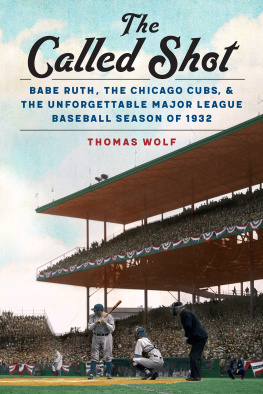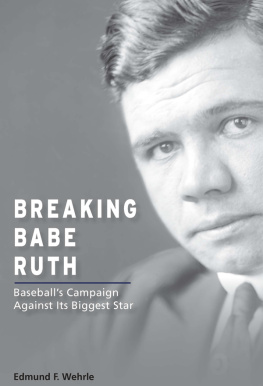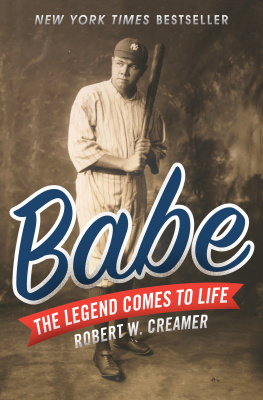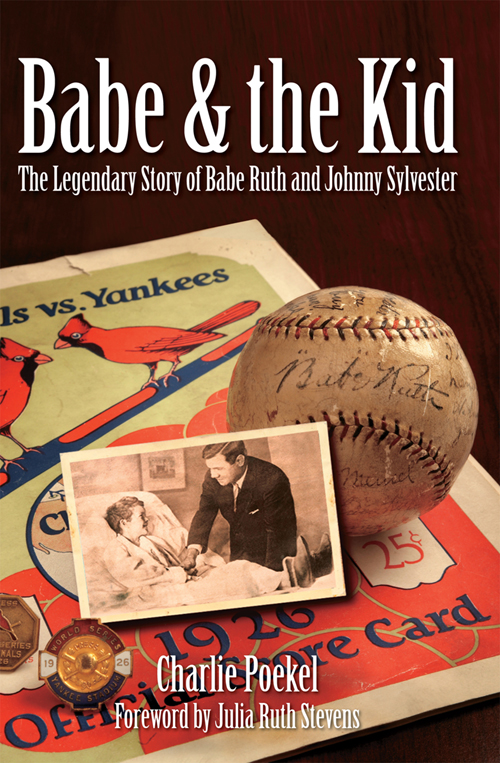Babe & the Kid
Babe & the Kid
The Legendary Story of Babe Ruth and Johnny Sylvester
Charlie Poekel
Foreword by Julia Ruth Stevens

Published by The History Press
Charleston, SC 29403
www.historypress.net
Copyright 2007 by Charlie Poekel
All rights reserved
Cover design by Kenny Evans. Photos by Brett Wood and the New York Daily News. Memorabilia courtesy of the Babe Ruth Museum and John Dale Sylvester Jr.
First published 2007
e-book edition 2011
ISBN 978.1.61423.096.0
Library of Congress Cataloging-in-Publication Data
Poekel, Charlie.
The babe and the kid : the legendary story of Babe Ruth and Johnny
Sylvester / Charlie Poekel.
p. cm.
Includes bibliographical references and index.
print edition ISBN-13: 978-1-59629-267-3 (alk. paper)
1. Ruth, Babe, 1895-1948. 2. Ruth, Babe, 1895-1948--Friends and associates. 3. Sylvester, Johnny, 1915-1994. 4. Baseball players--United States--Biography. I. Title.
GV865.R8P64 2007
796.357092--dc22
[B]
2007035232
Notice: The information in this book is true and complete to the best of our knowledge. It is offered without guarantee on the part of the author or The History Press. The author and The History Press disclaim all liability in connection with the use of this book.
All rights reserved. No part of this book may be reproduced or transmitted in any form whatsoever without prior written permission from the publisher except in the case of brief quotations embodied in critical articles and reviews.
To my wife Lynn,
whose inspiration and love created this book.
Contents
Foreword
Kidshis own and everyone elseswere the delight of Daddys life. Daddy loved children and children loved him. What made this amazing was the rough time that my father had in his own childhood. For eight years of his life, he lived at the St. Marys Industrial School for Boys. What gave him the moral rectitude was the spirit and guidance of the Xaverian Brothers. And their spirit stayed with him all of his life.
Johnny Sylvester became a special friend of my dads and his friendship lasted a lifetime. He was not a creation of the press. When my dad received the news of a boy in need of help, he responded. Of all the Yankees on the 1926 team, my dad was the one who wrote on a special baseball, Ill knock a homer for you in Wednesdays game. This book tells what happened after he wrote those encouraging words to one very special eleven-year-old boy in Essex Fells, New Jersey.
The story as told in this book is incredible and should be an inspiration to everyoneyoung and old. My dad believed in young people. Throughout his life he, more than anyone else in the history of the United States, believed in young people.
On Babe Ruth Day, my dad spoke of the need for young people to learn baseball. He said, Baseball has to start with the young, for you cannot learn baseball when you are older.
When my dad was too ill to attend the funeral of Brother Gilbert, who was responsible for him entering baseball, he received an offer from a ten-year-old boy to attend in his place. My dad didnt hesitate when receiving the offer and allowed young Frank Haggerty of Danvers, Massachusetts, to represent him. No one linked the boys with the men more than my dad. As my dad related to boys, the boys related to my dad.

Julia Ruth Stevens, daughter of Babe Ruth, sitting with her father. Courtesy of the Associated Press.
It is my foremost desire that this book will put forth the historical facts once and for all and be an everlasting tribute to a man whose likes we will never see again.

Acknowledgements
First and foremost I want to thank John Dale Sylvester Jr., who allowed me unlimited access to the Sylvester family records and his fathers priceless scrapbook, which was started by an eleven-year-old boy living in Essex Fells, New Jersey. As Johnny never sought publicity for himself from his experiences with the great Babe Ruth, neither has his son or his family. But the Sylvesters recognize the importance of the story and the publics fascination with it for over eighty-one years.
Secondly, I want to thank Julia Ruth Stevens, who encouraged me to write the book and who through her stories and anecdotes about her father made the Great Bambino come alive for me.
And I want to thank all of the people who opened up their files and their resources for the research of this book. They came from various walks of life in order to complete the story. There were Bob Perna and Rick Hyer, tracing deeds of the Sylvester homes; Julie Bartlett, curator of the Calvin Coolidge Presidential Library & Museum, finding photographs; Molly Kodner, associate archivist at the Missouri Historical Society, locating the handwritten flight logs of Charles A. Lindbergh for his airmail routes between St. Louis and Chicago for October of 1926; Tracy Crocker, performing genealogical work on the Sylvester line; and Greg Schwalenberg, director of the Babe Ruth Museum in Baltimore, opening up the museums display cases so that Brett Wood could photograph the prized Sylvester autographed baseballs.
And special thanks to those who used their time and their talents to bring this book about in the best possible light: Brett Wood, a great still-life photographer who spent hours photographing baseballs, the letters from Babe Ruth, Red Grange, Bill Tilden and others, along with the other treasures found in Johnny Sylvesters scrapbook; Kenny Evans, whose tremendous artistic talent and love of baseball resulted in the excellent cover and photographs; Doug Wyatt for obtaining the Sylvester patents; Laurie Hoonhout McFeely from the Montclair-Kimberly Alumni Association; Ben Sakoguchi, who furnished his great artwork; Barrett Zinderman for doing what she does best: coordinating the talent and making things happen; Michael G. Bracey, who secured John Dale Sylvesters military records and deck logs from SC-520; Becky Redington, who ensured the high quality of the text formatting; and Chris Weston, who superbly formatted the images.
Many thanks to those who graciously consented to oral interviews: Ruth Elliott, who was there when the Babe walked through the door; John Dale Sylvester Jr., who is the custodian of his fathers mementos; Robert Bush, who went to grammar school with Johnny Sylvester; Ted Keenan, who worked and sailed with Johnny; and Dan Bern, who spoke about the story and played his captivating song Johnny Sylvester Comes Back to Visit the Babe in his dressing room for me before appearing in Brooklyn, New York.
My appreciation also to Anne McCauley, Tim Cutting, Charles Stewart, Walter Giordano and Jean Giordano for furnishing research material. And to Tom Dawes and Rose Cali for their advice and suggestions.
And to the many unnamed individuals who work every day and perform such excellent work at the New York Public Library, the Boston Public Library, the Newark Public Library, Princeton University and the National Baseball Hall of Fame at Cooperstown, New York, who all helped me with my research.









